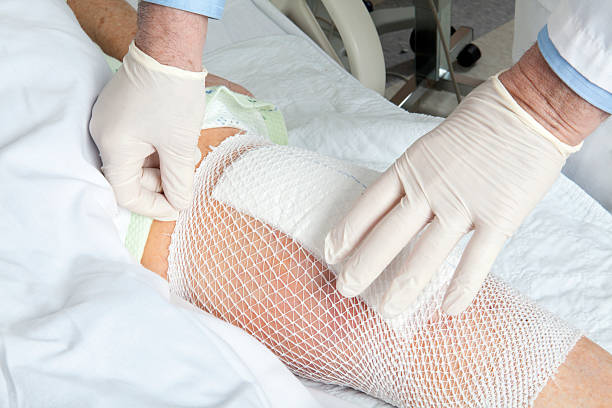
Total knee replacement, also known as total knee arthroplasty, is a widely performed orthopaedic surgery that aims to relieve pain and restore function in patients with severely damaged knee joints. Most commonly, the procedure is recommended for individuals with advanced osteoarthritis, rheumatoid arthritis or traumatic injury that has led to incapacitating knee pain and loss of mobility. Total knee replacement has a high success rate and can significantly improve the quality of life for patients. However, the most asked question of patients is, “ Does a total knee replacement really work like a normal, healthy knee? The answer to this question can be obtained by exploring how a natural knee functions and how a knee replacement works with precautions after surgery.
Understanding the normal Knee
Understanding the procedure of knee replacement
Comparison of total knee replacement to a natural knee
1 Range of motion
2. Strength and endurance
3. Proprioception and sensation
4. Plain Relief vs natural feel
Psychological and lifestyle considerations
Factors that made the knee feel normal after replacement
1 Surgical technique and implant design
2 Patient factors
3 Surgeon Experience
The knee joint is the biggest joint in the body, which connects the thigh bone (femur) to the shin bone (tibia) to help stand, move and keep a good balance. The knees also contain cartilage, like the meniscus, and ligaments, including the LCL, MCL, ACL and PCL. These bones are cushioned by cartilage, stabilised by ligaments, and moved by muscles and tendons. Synovial fluid lubricates the joint to allow a smooth and pain-free motion. A healthy knee allows different activities, which include walking, running, climbing, kneeling, pivoting and squatting with a wide range of motion and minimal discomfort. Moreover, when arthritis or injury damages the bone structure, it leads to pain, stiffness, swelling and reduced mobility. However, total knee replacement becomes an option, particularly when conservative treatments like physical therapy, medications or injections are not effective for providing relief.
A total knee replacement is the most common type of knee replacement. This is where the lower end of your thigh bone and the upper end of your shin bone are replaced with metal and plastic parts. This procedure involves different steps. In the first step, the surgeon cuts down the front of the knee and moves the kneecap to the side so they can get to the knee joint behind it. In the second step, new cartilage is fitted over the ends of both bones to create the new joint. The parts are usually made of metal and plastic. Some people may also have the back of the kneecap replaced with a new part. The surgeon closes the cut on your knee using stitches or clips and covers it with a dressing and bandage. After the operation, an individual stays in a recovery room until they fully awake, where they may be given medicines to help with the pain.
The primary goal of Total knee replacement is to relieve pain and restore function. Moreover, the success rate of total knee replacement is high, with over 90% of patients experiencing significant improvement in knee function and pain relief. However, the question of whether it functions exactly like a normal knee requires a deeper look.
A healthy knee typically has a bending range of about 135-145 degrees. After total knee replacement, most patients achieve a functional range of 110-120 degrees, which is sufficient for walking, climbing stairs, sitting and light recreational activities. However, activities requiring deep bending, such as kneeling, squatting or certain supports, may remain difficult or impossible. However, overall flexibility is still restored even with an excellent surgical outcome.
While the knee replacement can relieve pain and increase mobility, it does not automatically restore muscle strength. Moreover, post-operative rehabilitation is significant to rebuild strength and endurance, but the replaced knee may never feel as strong or responsive as a natural knee does. This feeling is more prominent, particularly in athletic activities.
Natural knees are equipped with nerve endings that provide proprioception to the ability of the body to sense joint position and movement. This helps in balance, coordination and reactive movement, but patients are mostly reporting a sensation of artificiality in the knees or describe it as a feeling of a mechanical object moving in their body. However, after the procedure of knee replacement, proprioception is reduced because the artificial components do not have nerve endings.
Most of the patients report significant pain relief right after the surgery, which is a major success of total knee replacement. However, about 15-20% of patients report discomfort, stiffness or dissatisfaction. While the pain is mostly less than before surgery, I always feel normal. However, some patients feel a clicking or clunking sensation during motion due to the mechanical nature of the prosthesis.
Patients mostly approach total knee replacement with high expectations and hopes to return to their daily activities. While the other individuals are satisfied with the results of the procedure, expectations must be managed. A replaced knee can allow for a return to walking, swimming, golfing, and even biking, but high-impact sports like running or jumping are discouraged. In addition, the artificial knee may require some lifestyle modifications, which include yoga positions, deep squats or kneeling and taking special care in winter with joint-friendly exercises.
Advancements in surgical techniques, such as minimal invasive approaches and computer-assisted navigation to improve alignment and implant positioning, will be better. Similarly, newer implant designs aim to mimic the natural motion of the knee more closely. Some offer better stability and range of motion, but no implant can perfectly replicate the natural knee.
Age, weight, fitness level and the presence of other medical conditions like diabetes or arthritis in other joints may affect recovery and outcome of the procedure. Moreover, younger patients may demand more from their knees, while older patients may feel more satisfied with improved mobility and less pain. On the other hand, a successful recovery mostly depends on a patient’s commitment to physical therapy and strengthening exercises. However, good outcomes are closely linked to diligent rehabilitation over several months.
Outcomes are generally better and improved when the procedure is performed by experienced surgeons in joint replacement. Their familiarity with implant choices and surgical nuances contributes to better results. However, total knee replacement does not work exactly like a normal knee and also can not replicate the intricate biomechanics, sensation or full functionality of a natural and healthy joint. However, the answer to the given question is that the majority of patients offer a significant improvement over their pre-operative condition.

This post has been authored and published by one of our premium contributors, who are experts in their fields. They bring high-quality, well-researched content that adds significant value to our platform.


